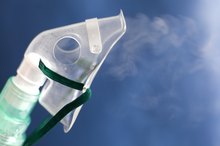Symptoms of Food in the Lungs
When food or a liquid enters the lungs, it is called aspiration pneumonia 123. A common cause might come from inhaling stomach acid or vomit or if food, liquid or spit from your mouth accidentally gets into the airway and travels down into the lungs. Aspiration pneumonia can damage the lungs or cause a blockage, according to Drugs.com 123. This damage can cause either swelling or fluid in the lungs to build up and lead to an infection, such as bacterial pneumonia.
If you are experiencing serious medical symptoms, seek emergency treatment immediately.
Frequent Cough
One of the symptoms of aspiration pneumonia is a frequent cough that brings up bad-smelling phlegm that may have blood streaks or pus in it or if you experience chest pain when you cough 123. You may also cough up a bubbly fluid from your lungs.
Shortness of Breath
Signs & Symptoms of Relapse From Pneumonia
Learn More
Another sign of aspiration pneumonia is the feeling like you can't get enough air into your lungs or you have wheezing, which is a high-pitched whistling sound while you breath 123. Your resting heart rate and breathing may seem faster than normal and your skin, lips or fingernails may have a somewhat dark, dusky tinge or bluish color to them.
Swallowing Problems
Having the feeling that something is stuck in your throat or something is stuck from the neck down to just above your abdomen behind the breastbone is another symptom of aspiration pneumonia, notes MedlinePlus, an online resource of the National Institutes of Health 123.
Fatigue and Dizziness
Bronchitis Symptoms With Allergies
Learn More
Other symptoms of aspiration pneumonia include feeling weary, tired or lacking in energy, or feeling dizzy, faint or confused 123.
Treatment
Treatment for aspiration pneumonia may include being hospitalized where the severity of the pneumonia can be properly assessed 123. The patient may receive antibiotics, which treat the bacteria that may be present in the lungs. The type of antibiotic used depends on the patient's health, if they live at home or in a long-term nursing facility, their recent antibiotic use and whether they've been hospitalized recently, states MedlinePlus. If a solid object was inhaled, a bronchoscopy may need to be used to remove it. The procedure uses a small, flexible scope that is passed through the mouth and into the lungs. Aspiration pneumonia can be a serious, life-threatening medical problem because of the risk of developing a lung infection that may spread to the bloodstream or other parts of the body, so if you experience any of the symptoms discussed, seek medical treatment immediately 123.
Related Articles
References
- Medline Plus: Aspiration Pneumonia
- The Doctors of USC: Aspiration Pneumonia
- DiBardino, D. and Wunderink, R. Aspiration pneumonia: a review of modern trends. J Crit Care. 2015;30(1):40-8. DOI: 10.1016/j.jcrc.2014.07.011
- Lanspa, M.; Jones, B.; Brown, S. et al. Mortality, morbidity, and disease severity of patients with aspiration pneumonia. J Hosp Med. 8(2):83-90. DOI: 10.1002/jhm.1996
- Ruscello, D. The Role of the Speech-Language Pathologist in Managing Dysphagia in the Elderly. J Gerontol Geriatr Res. 4:213. DOI: 10.4172/2167-7182.1000213
- Sarkar, P; Chandak, T.; Shah, R. et al. Diagnosis and management bronchopleural fistula. Indian J Chest Dis Allied Sci. 52(2):97-104.
- Son, Y.; Shin, J.; and Ryu, H. Pneumonitis and pneumonia after aspiration. J Dent Anesth Pain Med. 17(1):1-12. DOI: 10.17245/jdapm.2017.17.1.1
Writer Bio
Lori Myers hails from Upstate New York, in the Adirondack region. She has written for the "Schenectady Gazette" and began writing professionally in 1995. She is a certified personal trainer and is currently expanding her education in computer programming. Myers obtained her bachelor's degree in journalism and her master's degree in nutrition from Syracuse University.








